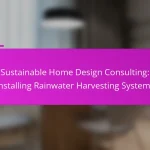Sustainable home design is guided by key regulations and local codes that emphasize energy efficiency and environmental responsibility. In regions like California, these guidelines play a crucial role in shaping residential projects, ensuring compliance with standards that promote water conservation and the use of eco-friendly materials. Understanding and adhering to these regulations is vital for homeowners and builders committed to creating sustainable living spaces that minimize environmental impact.
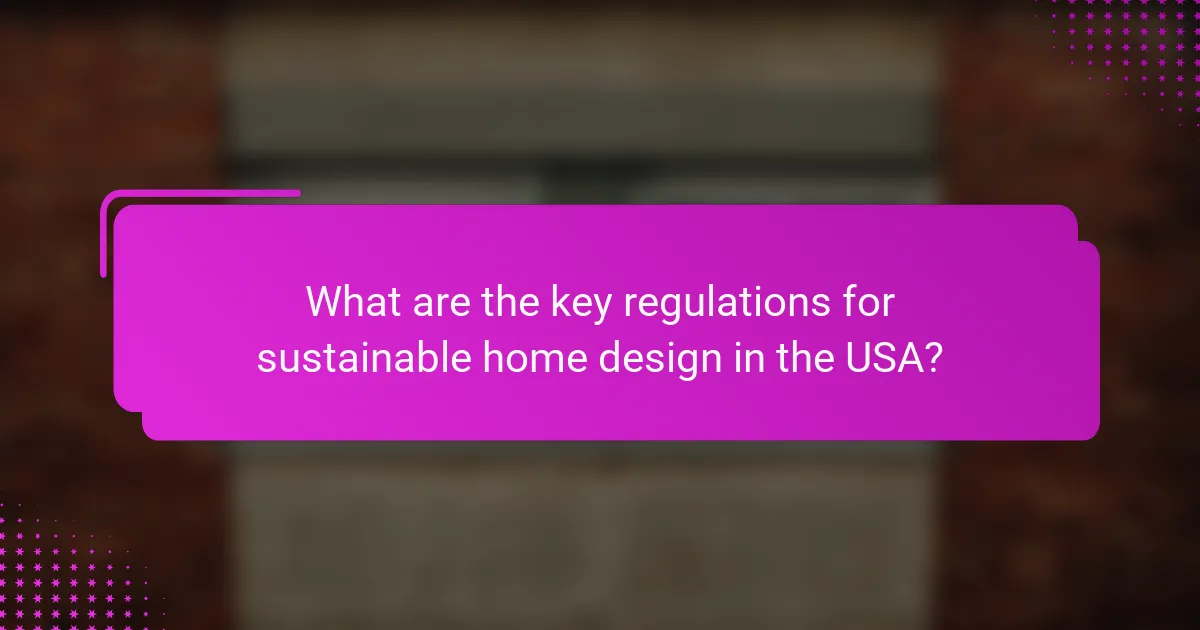
What are the key regulations for sustainable home design in the USA?
Key regulations for sustainable home design in the USA include various codes and certifications that promote energy efficiency and environmental responsibility. Understanding these regulations is essential for compliance and maximizing the sustainability of residential projects.
International Energy Conservation Code (IECC)
The International Energy Conservation Code (IECC) sets minimum energy efficiency standards for residential buildings across the USA. It covers aspects such as insulation, window performance, and HVAC systems to reduce energy consumption.
When designing a home, ensure that your plans meet the latest IECC requirements, which may vary by state or locality. Regular updates to the code mean that builders should stay informed about any changes that could affect their projects.
Leadership in Energy and Environmental Design (LEED)
Leadership in Energy and Environmental Design (LEED) is a widely recognized green building certification program that evaluates the environmental performance of buildings. It awards points for sustainable practices in areas like energy use, water efficiency, and materials selection.
To achieve LEED certification, consider integrating renewable energy sources, using sustainable materials, and implementing efficient water management systems. Each level of certification—Certified, Silver, Gold, and Platinum—requires a specific number of points, guiding your design choices.
Energy Star Certification
Energy Star Certification is a program that identifies energy-efficient homes and products, helping homeowners save on utility bills while reducing environmental impact. Homes that meet Energy Star standards are at least 10% more efficient than typical new homes.
To qualify for Energy Star Certification, focus on high-performance windows, proper insulation, and energy-efficient appliances. This certification not only enhances the sustainability of your home but can also increase its market value.
Local Building Codes
Local building codes vary significantly across different regions and municipalities, often including specific requirements for sustainable design. These codes may dictate energy efficiency measures, materials used, and construction practices.
Before starting a project, consult your local building authority to understand the specific codes that apply to your area. Compliance with these codes is crucial for obtaining necessary permits and ensuring the safety and sustainability of your home design.

How do local codes impact sustainable home design in California?
Local codes in California significantly influence sustainable home design by establishing guidelines that promote energy efficiency, water conservation, and environmentally friendly materials. Compliance with these regulations is essential for homeowners and builders aiming to create sustainable living spaces.
California Green Building Standards Code (CALGreen)
The California Green Building Standards Code, known as CALGreen, sets mandatory requirements for new residential and commercial buildings to enhance sustainability. This code emphasizes energy efficiency, water conservation, and the use of sustainable materials, ensuring that buildings are designed with environmental considerations in mind.
Key areas covered by CALGreen include site development, resource efficiency, energy efficiency, and indoor environmental quality. For instance, CALGreen mandates that new homes incorporate features such as low-flow plumbing fixtures and energy-efficient lighting, which can reduce water and energy consumption significantly.
Title 24 Energy Standards
Title 24 Energy Standards are a set of regulations that dictate energy efficiency requirements for residential and non-residential buildings in California. These standards are updated periodically to reflect advancements in technology and energy-saving practices, ensuring that new constructions contribute to the state’s energy goals.
Under Title 24, builders must adhere to specific guidelines regarding insulation, HVAC systems, and renewable energy sources. For example, homes are required to have a minimum level of insulation and may need to include solar panels to meet energy production targets. Understanding these standards is crucial for compliance and can lead to long-term savings on energy bills.
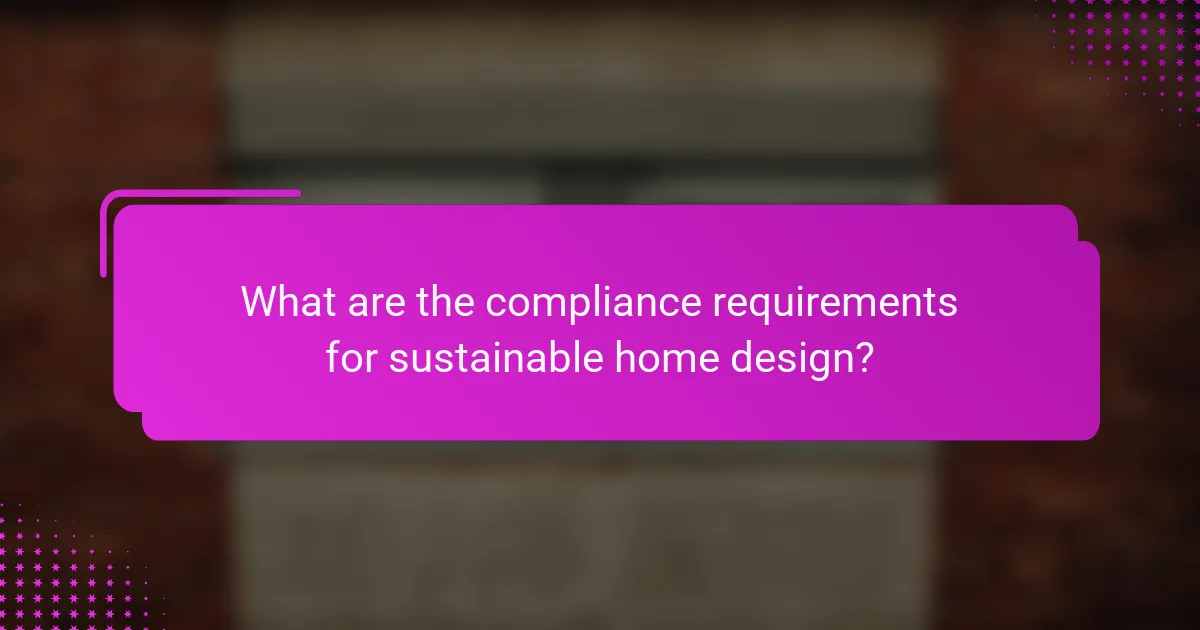
What are the compliance requirements for sustainable home design?
Compliance requirements for sustainable home design typically include adherence to local building codes, environmental regulations, and energy efficiency standards. These regulations ensure that homes are constructed in a way that minimizes environmental impact while promoting safety and sustainability.
Permitting Process
The permitting process for sustainable home design involves obtaining the necessary approvals from local authorities before construction begins. This often includes submitting detailed plans that demonstrate compliance with zoning laws, environmental regulations, and energy codes.
Homeowners should expect to provide documentation such as site plans, energy calculations, and materials specifications. It’s advisable to consult with local building departments early in the design phase to understand specific requirements and avoid delays.
Inspections and Certifications
Inspections and certifications are critical to ensure that sustainable homes meet established standards throughout the construction process. Local building inspectors will typically assess compliance with safety codes, energy efficiency, and environmental regulations at various stages of construction.
Additionally, obtaining certifications such as LEED (Leadership in Energy and Environmental Design) or Energy Star can enhance the credibility of a sustainable home. These certifications often require third-party verification, which can involve additional inspections and documentation to confirm that the home meets specific sustainability criteria.
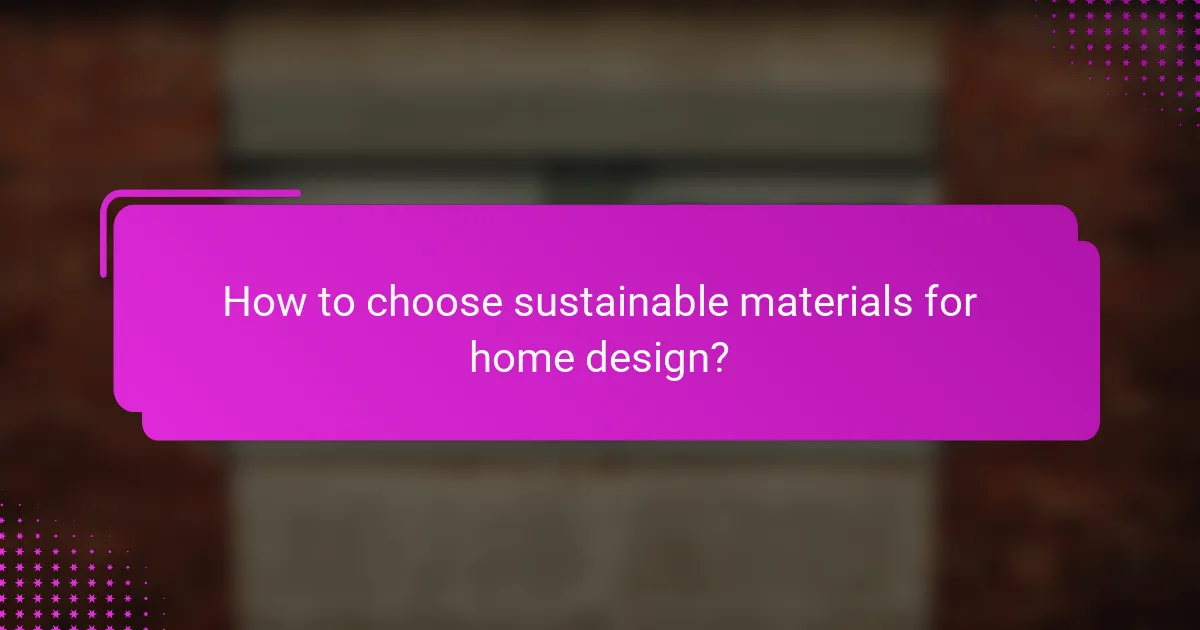
How to choose sustainable materials for home design?
Choosing sustainable materials for home design involves selecting options that minimize environmental impact while ensuring durability and efficiency. Focus on materials that are recycled, low in harmful emissions, and contribute to energy efficiency in your home.
Recycled and Reclaimed Materials
Recycled and reclaimed materials are excellent choices for sustainable home design as they reduce waste and the need for new resources. Consider using reclaimed wood for flooring or furniture, which not only adds character but also lowers the carbon footprint associated with new timber production.
When selecting recycled materials, look for products made from post-consumer waste, such as recycled glass countertops or insulation made from recycled paper. These options can provide both aesthetic appeal and functional benefits while supporting a circular economy.
Low-VOC Products
Low-VOC (volatile organic compounds) products are essential for maintaining indoor air quality and reducing environmental harm. Opt for paints, adhesives, and finishes that are labeled as low-VOC to minimize harmful emissions in your home.
When shopping for low-VOC products, check for certifications like Green Seal or Greenguard, which indicate compliance with stringent environmental standards. This ensures that the materials you choose contribute to a healthier living environment.
Energy-Efficient Appliances
Energy-efficient appliances are crucial for sustainable home design as they significantly reduce energy consumption and utility costs. Look for appliances with the ENERGY STAR label, which signifies that they meet strict efficiency guidelines set by the U.S. Environmental Protection Agency.
When upgrading appliances, consider the long-term savings on energy bills. For example, an energy-efficient refrigerator can save hundreds of dollars over its lifespan compared to a standard model. Prioritize appliances that not only conserve energy but also fit your lifestyle and needs.
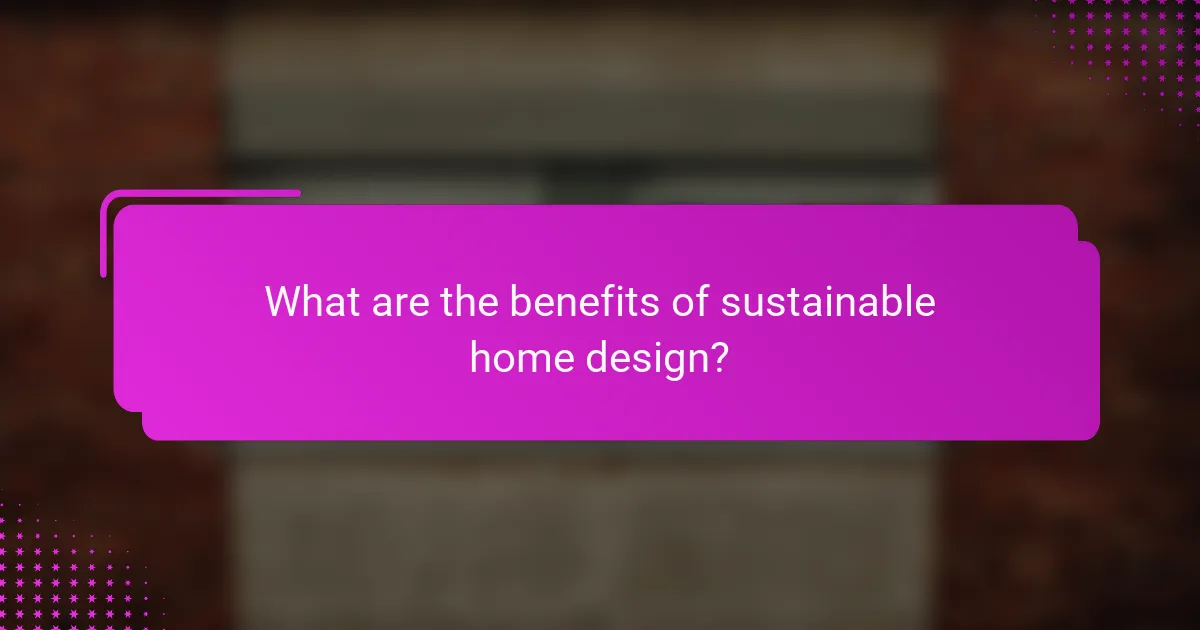
What are the benefits of sustainable home design?
Sustainable home design offers numerous advantages, including reduced environmental impact and enhanced quality of life. By incorporating eco-friendly materials and energy-efficient systems, homeowners can enjoy long-term savings and healthier living conditions.
Energy Cost Savings
One of the primary benefits of sustainable home design is significant energy cost savings. Homes designed with energy efficiency in mind often utilize high-quality insulation, energy-efficient windows, and renewable energy sources such as solar panels, which can lower utility bills by a considerable margin.
For instance, homeowners can expect to save anywhere from 20% to 50% on energy costs compared to traditional homes. Additionally, many regions offer incentives or rebates for energy-efficient upgrades, further enhancing savings.
Improved Indoor Air Quality
Sustainable home design promotes improved indoor air quality through the use of non-toxic materials and effective ventilation systems. By selecting low-VOC (volatile organic compounds) paints, finishes, and furnishings, homeowners can reduce harmful pollutants and allergens in their living spaces.
Moreover, incorporating proper ventilation and air filtration systems helps maintain fresh air circulation, which is crucial for health. This focus on air quality can lead to fewer respiratory issues and a more comfortable living environment.

What are the challenges in achieving compliance?
Achieving compliance in sustainable home design involves navigating various regulations and codes that can vary significantly by location. Key challenges include understanding local requirements, managing costs, and ensuring that materials meet sustainability standards.
Understanding Local Regulations
Local regulations dictate the standards for sustainable building practices, including energy efficiency, waste management, and water conservation. Homeowners and builders must familiarize themselves with zoning laws, building codes, and environmental regulations specific to their area.
For instance, in the United States, the International Energy Conservation Code (IECC) sets benchmarks for energy efficiency that many states adopt. Checking with local authorities can help clarify which codes apply and what permits are necessary.
Cost of Sustainable Materials
The cost of sustainable materials can be higher than traditional options, which may pose a challenge for compliance. Prices for eco-friendly products often range from 10% to 50% more than conventional materials, depending on the type and source.
When budgeting for sustainable design, consider the long-term savings on energy bills and maintenance. Investing in high-quality insulation or energy-efficient windows may have a higher upfront cost but can lead to significant savings over time.

